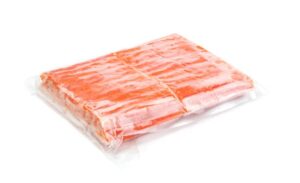Frozen seafood options are popular for many consumers because they offer the same high-quality protein without the expensive and time-consuming shipping process. Frozen seafood products have a longer shelf life, eliminating waste.
 Additionally, many of these products are frozen at sea and adhere to the Friend of the Sea standards. This helps consumers support sustainable fishing practices. For more frozen seafood options, check this out!
Additionally, many of these products are frozen at sea and adhere to the Friend of the Sea standards. This helps consumers support sustainable fishing practices. For more frozen seafood options, check this out!
Cost
Frozen seafood options can provide consumers with a nutritious and cost-effective choice. Seafood is an excellent source of omega-3 fatty acids, protein, vitamins, and minerals and can help lower the risk of chronic diseases such as heart disease and certain cancers.
Additionally, frozen seafood can be prepared using various cooking methods, making it a convenient option for busy individuals or families looking to reduce their meal planning and food preparation time.
As the global market for frozen seafood continues to grow, industry participants need to address consumer quality concerns and maintain sustainable sourcing practices. These steps can help boost brand loyalty and drive future growth in this competitive segment of the seafood industry.
Convenience
Seafood is an excellent source of protein, iodine and selenium. It also contains omega-3 fats, which are essential for heart health. However, fresh seafood has a limited shelf life and can be challenging in rural areas or small towns. Frozen seafood options can make getting the recommended two fish meals easier per week.
Several brands offer convenient and high-quality frozen seafood. These products are made using advanced methods, such as pressure, ultrasound and electrically assisted freezing. They are also labelled to show the country of origin and sustainability certifications. For more frozen seafood options, check this out!
For example, Kroger’s exclusive seafood brand Orca Bay offers frozen cod fillets that are non-GMO, sustainably harvested and contain no additives or preservatives. Young recommends trying the breaded version of these fillets, as they are juicy, dense, and low in sodium. Another option is Open Nature Seafood, available in Albertsons and other Kroger-owned stores. This earth-friendly product line is free of antibiotics and added hormones and offers a range of seafood species.
Variety
The wide variety of frozen seafood options allows consumers to find a food that suits their taste and cooking style. Options include fillets and servings, marinated alternatives, specialty cuts and breaded alternatives. These choices help eliminate seasonal restrictions and offer flexibility in menu planning.
Breaded frozen fish options such as cod fillets and battered haddock are popular among children and adults for their crispy coating and mild-tasting fish. These foods are easy to cook and serve and often pair well with dipping sauces.
Many frozen seafood options are sustainably sourced and individually flash-frozen to maintain their freshness. Dietitians recommend choosing frozen fish from brands labelled as wild-caught or sustainably sourced to support the ocean’s health.
Freshness
Frozen seafood helps reduce food waste along the supply chain – after it’s caught, during transport and while waiting to be sold or eaten. By contrast, fresh seafood spoils rapidly, so 23% of the seafood sold at supermarkets ends up in the trash, according to Eco-Trust.
Seafood frozen right after it’s caught retains its nutrients and texture because modern technology locks in delicate flavours. For consumers, that means a heart-healthy choice less expensive than fresh seafood. For more frozen seafood options, check this out!
Another reason frozen seafood is a popular choice is because it can be incorporated into meal plans without requiring extensive forethought. Unlike fresh fish that must be consumed within a few days of purchase, many frozen seafood brands can last several months when stored properly, making it easier to prepare meals on demand. Moreover, pre-portioned packages of frozen seafood simplify meal preparation and help control portion intake. That’s a win for busy cooks who may find it challenging to plan and shop for fresh seafood regularly.
Benefits of Frozen Seafood
Seafood has a reputation for fading fast in the fridge, but with proper storage techniques, frozen seafood can last just as long as fresh seafood. Suppose you purchase your fish from a quality provider like Morey’s or Better Fish. In that case, their individually blast-frozen and vacuum-sealed portions will keep at or below -20 degrees for months before they lose their flavour and texture.